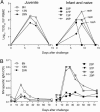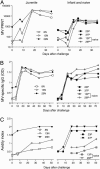Modulation of disease, T cell responses, and measles virus clearance in monkeys vaccinated with H-encoding alphavirus replicon particles
- PMID: 16037211
- PMCID: PMC1187989
- DOI: 10.1073/pnas.0504592102
Modulation of disease, T cell responses, and measles virus clearance in monkeys vaccinated with H-encoding alphavirus replicon particles
Abstract
Measles remains a major worldwide problem partly because of difficulties with vaccination of young infants. New vaccine strategies need to be safe and to provide sustained protective immunity. We have developed Sindbis virus replicon particles that express the measles virus (MV) hemagglutinin (SIN-H) or fusion (SIN-F) proteins. In mice, SIN-H induced high-titered, dose-dependent, MV-neutralizing antibody after a single vaccination. SIN-F, or SIN-H and SIN-F combined, induced somewhat lower responses. To assess protective efficacy, juvenile macaques were vaccinated with a single dose of 10(6) or 10(8) SIN-H particles and infant macaques with two doses of 10(8) particles. A dose of 10(8) particles induced sustained levels of high-titered, MV-neutralizing antibody and IFN-gamma-producing memory T cells, and most monkeys were protected from rash when challenged with wild-type MV 18 months later. After challenge, there was a biphasic appearance of H- and F-specific IFN-gamma-secreting CD4+ and CD8+ T cells in vaccinated monkeys, with peaks approximately 1 and 3-4 months after challenge. Viremia was cleared within 14 days, but MV RNA was detectable for 4-5 months. These studies suggest that complete clearance of MV after infection is a prolonged, phased, and complex process influenced by prior vaccination.
Figures





Similar articles
-
A chimeric alphavirus replicon particle vaccine expressing the hemagglutinin and fusion proteins protects juvenile and infant rhesus macaques from measles.J Virol. 2010 Apr;84(8):3798-807. doi: 10.1128/JVI.01566-09. Epub 2010 Feb 3. J Virol. 2010. PMID: 20130066 Free PMC article.
-
Vaxfectin adjuvant improves antibody responses of juvenile rhesus macaques to a DNA vaccine encoding the measles virus hemagglutinin and fusion proteins.J Virol. 2013 Jun;87(12):6560-8. doi: 10.1128/JVI.00635-13. Epub 2013 Apr 3. J Virol. 2013. PMID: 23552419 Free PMC article.
-
Use of Vaxfectin adjuvant with DNA vaccine encoding the measles virus hemagglutinin and fusion proteins protects juvenile and infant rhesus macaques against measles virus.Clin Vaccine Immunol. 2008 Aug;15(8):1214-21. doi: 10.1128/CVI.00120-08. Epub 2008 Jun 4. Clin Vaccine Immunol. 2008. PMID: 18524884 Free PMC article.
-
Neutralizing B cell response in measles.Viral Immunol. 2002;15(3):451-71. doi: 10.1089/088282402760312331. Viral Immunol. 2002. PMID: 12479395 Review.
-
Current animal models: cotton rat animal model.Curr Top Microbiol Immunol. 2009;330:89-110. doi: 10.1007/978-3-540-70617-5_5. Curr Top Microbiol Immunol. 2009. PMID: 19203106 Review.
Cited by
-
Measles Epidemics Among Children in Vietnam: Genomic Characterization of Virus Responsible for Measles Outbreak in Ho Chi Minh City, 2014.EBioMedicine. 2014 Oct 29;1(2-3):133-40. doi: 10.1016/j.ebiom.2014.10.015. eCollection 2014 Dec. EBioMedicine. 2014. PMID: 26137521 Free PMC article.
-
Profile of Diane E. Griffin.Proc Natl Acad Sci U S A. 2005 Aug 16;102(33):11578-80. doi: 10.1073/pnas.0505531102. Epub 2005 Aug 8. Proc Natl Acad Sci U S A. 2005. PMID: 16087864 Free PMC article. No abstract available.
-
The next frontier in vaccine design: blending immune correlates of protection into rational vaccine design.Curr Opin Immunol. 2022 Oct;78:102234. doi: 10.1016/j.coi.2022.102234. Epub 2022 Aug 13. Curr Opin Immunol. 2022. PMID: 35973352 Free PMC article. Review.
-
Sindbis virus-based measles DNA vaccines protect cotton rats against respiratory measles: relevance of antibodies, mucosal and systemic antibody-secreting cells, memory B cells, and Th1-type cytokines as correlates of immunity.J Virol. 2009 Mar;83(6):2789-94. doi: 10.1128/JVI.02191-08. Epub 2009 Jan 7. J Virol. 2009. PMID: 19129445 Free PMC article.
-
Viral Replicon Systems and Their Biosafety Aspects.Appl Biosaf. 2023 Jun 1;28(2):102-122. doi: 10.1089/apb.2022.0037. Epub 2023 Jun 5. Appl Biosaf. 2023. PMID: 37342518 Free PMC article. Review.
References
-
- Centers for Disease Control (2003) Morbid. Mortal. Wkly. Rep. 52, 471–475. - PubMed
-
- Muscat, M., Glismann, S. & Bang, H. (2003) Euro. Surveill. 8, 123–129. - PubMed
-
- Moss, W. J., Monze, M., Ryon, J. J., Quinn, T. C., Griffin, D. E. & Cutts, F. (2002) Clin. Infect. Dis. 35, 189–196. - PubMed
-
- Cutts, F. T., Henao-Restrepo, A. & Olive, J. M. (1999) Vaccine 17, Suppl. 3, S47–S52. - PubMed
-
- Centers for Disease Control (2000) Morbid. Mortal. Wkly. Rep. 49, 1116–1118. - PubMed
Publication types
MeSH terms
Substances
Grants and funding
LinkOut - more resources
Full Text Sources
Other Literature Sources
Medical
Research Materials

